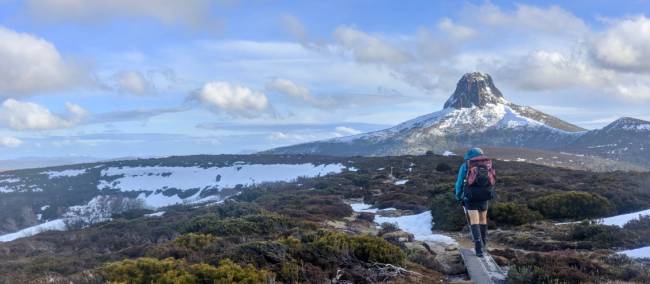
Walking the Overland Track in the shoulder season | Nom Blaskhi
Blog home / Why you should consider visiting Tasmania in the shoulder seasons
The peak, active adventure seasons in Tasmania are the blissful months between November and March when the weather is warmer, the skies are generally clear, and the conditions are at their best for trekking, cycling and rafting.
However, this also makes it the most popular time to visit Tasmania, meaning areas such as the iconic Overland Track are busy with avid trekkers eager to explore Tasmania’s rich wilderness areas and take advantage of the conditions of the trail, weather and visibility.
But we'll let you in on a little secret, the shoulder months in spring and autumn, particularly during the months of April and October, offer equally impressive experiences, with plenty to see and do, and a much quieter trail. In fact, you might be surprised by all the benefits of embarking on an active adventure in Tasmania in the shoulder seasons, and even the winter months.
Enjoy fewer crowds
Wherever you go in the world, a major benefit of travelling in the shoulder seasons or off seasons is fewer tourists, and the same applies to Tasmania. Popular trekking trails are quieter, giving you more solitude on the trail, uninterrupted views and a generally more peaceful experience at your campsite.
This is especially true on the Overland Track where during the peak season when the magic of summiting Cradle Mountain to take in the expansive views over the Cradle Mountain National Park can be somewhat tarnished by all the other tourists clambering to do the same.
Travellers embarking on cycling trips down the east coast will find fewer cars on the road, making it feel like the long, sweeping and curving coastal roads have been reserved just for your cycle group.
Our picks for April and October: Experience the South Coast Track in April or book outside high season dates for the Flinders Island Walking Adventure and Cycle, Kayak Walk Tasmania when it is relatively solitude, and take advantage of expansive views with other travellers few and far between.
See unique flora and fauna
While summer travellers have the advantage of experiencing Tasmania in ideal weather conditions, travellers in autumn, winter and spring get to see a side of Tasmania few others than the locals do.
Tasmania's shoulder and off season highlights include:
- Colourful fungus and turning of the trees in autumn that transforms green rainforests into bursts of bright reds, oranges and yellows.
- The soft touch of snow during winter turns wilderness areas into winter wonderlands. There's something truly sublime about walking into a tranquil environment blanketed by snow and frozen lakes.
- Blossoming wildflowers in spring can emit a floral scent that carries with the wind.
- Incredible photo opportunities as you witness the changing colours of Tasmania's unique flora.

These seasonal nuances are so special in their own right and not to be overlooked – and are one of the main highlights of travelling Tasmania in the shoulder seasons.
Our picks for March to May: Join the Overland Track and Walls of Jerusalem departures over autumn and enjoy stunning shows of colour as the fagus beech trees erupt in vibrant hues of reds, yellows and oranges.
Snowshoeing experience in winter
If you thought Tassie was wild, wait 'til you experience it in winter. In the months leading up to and during winter, the remote trails of Tasmania turn into areas of sublime beauty, adorned with frozen lakes, winter grasses and snow-covered trails.
Between June and August – and sometimes into early September, many of Tasmania’s peaks are blanketed in snow, and the all-white landscape creates a picture-perfect winterland that few people explore.

And if you've never snowshoed, it's the perfect opportunity. Our experienced guides will help bring the track to life and teach first-time snowshoers the finer points of this popular style of alpine travel.
With the trail (almost) all to yourself, you’ll have unique photographic opportunities that few trekkers are able to experience.
Crisp, clear days in July and August bring the majestic snowy landscapes to life, a beautiful sight that stays with you long after you return home. Best of all, with fewer people on the track, the trail is much quieter and the environment more serene.
Our picks for June to August: Embark on the 7-day Overland Track Winter Trek or 4-day Walls of Jerusalem Winter Experience. While it is equally rewarding to explore these tracks over the autumn and summer periods, a winter exploration along these top Tasmanian trails is a must-do experience.
Better bargains
If you want to stretch your budget and make every dollar count, travelling Tasmania in the shoulder seasons can get you much more bang for your buck, especially when it comes to flights and pre and post-accommodation.
General peak season travel occurs around October and finishes early April, so it’s worth considering that during these months you’ll be paying higher prices than you would from May to September when there are some great deals running.

Additionally, some trips have high season surcharges due to the high demand for spaces on their trips during peak periods, so do consider visiting outside of high season periods to save money on these select trips.
Our shoulder season trip picks: Book departures between April and December and avoid paying high season surcharges on the Cradle Huts Overland Track, Bay of Fires Lodge Walk and Freycinet Experience Walk.